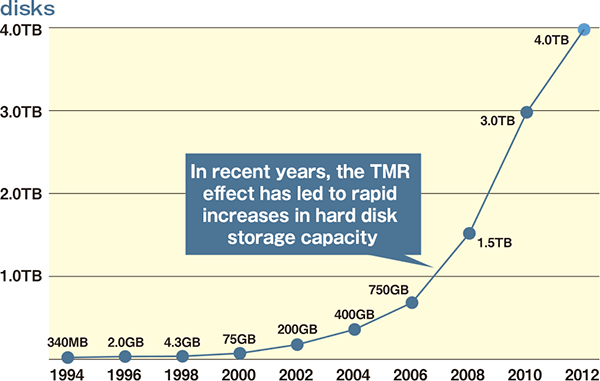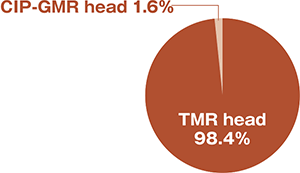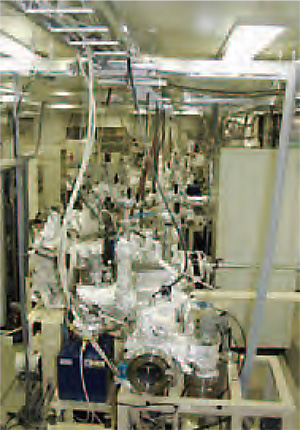Research Results
Increase the capacity of hard disk
Tunnel magnetoresistance (TMR) FY2016

- Shinji Yuasa (Director, Spintronics Research Center, The National Institute of Advanced Industrial Science and Technology)
- PRESTO
- Nanostructure and Material Property "Development of single-crystal TMR Devices for High-Density Magnetoresistive Random Access Memory" Researcher (2002-2006)
- SORST
- "Development of high-performance MgO-based magnetic tunnel junction devices and their application to next-generation MRAM" Research representative (2006)
- CREST
- Research of Innovative Material and Process for Creation of Next-generation Electronics Devices "Development of metal/oxide hybrid devices by novel deposition processes" Research Director (2009-2015)
A prodigious invention with a worldwide 98.4% share!
In recent years, hard disk capacity has continued to increase rapidly, with 4TB hard disks generally available for sale in 2012.
If we consider that the largest hard disk on sale in 2000 was 75GB, we can see that storage capacity expanded nearly by a factor of 50 over this 12-year period.
The (giant) tunnel magnetoresistance (TMR) element, which was developed by Mr. Shinji Yuasa and his team at PRESTO and SORST, has been playing an important role in the achievement of this dramatic progress. It is no exaggeration to state that without this research, current large-capacity hard disks would not have been possible. In fact, since around 2007, the number of commercially available large-capacity hard disks making practical use of TMR elements has skyrocketed.
Changes in storage capacity of commercially available hard disks

A trump card for increasing hard disk capacity : advanced magnetic heads
One of the most significant technologies for large- capacity hard disks was the development of magnetic heads. These were an essential technology for increasing memory capacity without changing the physical size of the hard disk itself by enabling the writing and reading of recorded information at ultra high densities. The magnetoresistance effect*1 is a physical phenomenon that magnetic heads use when reading information.
It can be argued that the evolution of magnetic heads represents the evolution of the magnetoresistance element. Each consecutive development of elements incorporating this new magnetoresistance effect has smashed the data storage barrier for hard disks.
Internal structure of a hard disk

The TMR effect makes huge evolutionary leaps with support from JST
With the discovery of giant magnetoresistance (GMR) in 1988 by German researcher Peter Grünberg and French researcher Albert Fert, the magnetoresistance effect suddenly gained a great deal of attention. Subsequently, a magnetoresistance ratio (MR)* 2 of 18% at room temperature an amazingly high value at the time was recorded in experiments in 1995 by Professor Terunobu Miyazaki of Tohoku
University, which further galvanized research in this area.
During the intense international competition in 2004 Shinji Yuasa's team was able to achieve a massive MR ratio of 230% at room temperature by using magnesium oxide (MgO): a phenomenon that he named TMR effect. This far exceeded any previous values, and greatly changed the future of the large- capacity hard disk drive. In fact, this principle saw practical application in 2007 a scant 3 years after Professor Yuasa's publication with this technology utilized in 98.4% of the 530 million hard disk units shipped around the world in the following year (2008).
Breakdown of magnetic head disks by material (2008) Fuji Chimera Research Institute estimate

Only a few low-end models still use CIP-GMR. TMR is expected to reach almost 100% usage in future.
Anticipated role as key element in high-performance non-volatile MRAM memory
Hard disks are not the only media used for computer memory. There is also flash memory, best known as USB memory and SSD, as well as semiconductor memory such as DRAM, which is used as a temporary memory device inside computers. Just as with hard disks, global development of these technologies is also fiercely competitive.
Widely anticipated as the next generation of semiconductor memory is magnetoresistive random- access memory (MRAM). As the name indicates, MRAM makes use of the magnetoresistance effect, utilizing an internal TMR element. MRAM has some major advantages: it reads and writes data extremely quickly, and is capable of preserving stored memory even without a power supply (i.e. is non-volatile). In future, the adoption of MRAM is expected to significantly reduce standby power consumption for computers, and to develop new memory that transcends the overwriting frequency constraints of flash memory.
The giant TMR element developed by Professor Yuasa' s team brought about the aforementioned significant impact upon the hard disk market; moreover, it holds the promise of similar potential in the future. Not only contributing to our present-day technology, but also effective in developing the technologies of the future: this is TMR effect research.
*1: The phenomenon whereby the electrical resistance of a material changes with magnetic fields.
*2: For elements using the magnetoresistance effect, the ratio between maximum resistance value and minimum resistance value when
changing with the presence of magnetic fields.
State-of-the-art single-crystal TMR manufacturing facility

